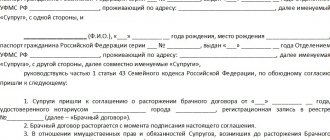For non-payment of alimony and the formation of debt, liability and the accrual of penalties are provided, so many debtors are wondering how to reduce alimony debt. This is possible if there are grounds provided for in Art. 114 RF IC. A reduction in the amount payable is permitted by agreement of the parties. When it comes to paying child support, disputes are resolved in court.
Grounds for reducing or canceling debt
Alimony obligations are established by agreement between the parties or in court. In the latter case, a writ of execution (IL) is issued, and when the case is considered in writ proceedings, a court order is issued.
In order not to pay a penalty of 0.1% of the amount, debtors try to reduce the amount of debt. Everything can be done if there are grounds provided for in Art. 114 RF IC.
The law states that the parties can reduce the debt by entering into a peace agreement. This is true when payments are intended to support former spouses or parents.
Articles on the topic (click to view)
- Assignment of the right to claim under alimony obligations is possible
- Formula for calculating penalties and fines for alimony: sample
- What are the consequences of not paying child support in 2020?
- Criminal liability for non-payment of alimony under Art. 157 of the Criminal Code of the Russian Federation
- Is alimony from financial assistance withheld for vacation?
- Find out the debt by name from the bailiffs for alimony
- Payment of alimony voluntarily without agreement
When paying money for the maintenance of a minor, the issue is resolved in court, including by agreement, when the recipient does not object to the reduction of the debt.
When it comes to reducing payments for children, this is possible for valid reasons for non-payment. According to the Resolution of the Plenum of the Armed Forces of the Russian Federation dated December 26, 20167 No. 56, these include:
- Compulsory military service. When the payer is sent to serve, alimony obligations are not canceled. In such a situation, he can turn to the bailiffs to suspend proceedings for the period of service, and the debt will not accrue. Production resumes upon returning home. Otherwise, a debt is formed, which can be reduced or canceled through the court.
- Treatment in a medical hospital. In such cases, an application for suspension of proceedings is not filed, and debt begins to accumulate. It can be canceled by submitting the relevant certificates.
- Changes in the financial situation of the alimony payer, the emergence of new dependents. When a child is born in a new marriage, the financial situation may worsen, which creates obstacles to repaying the debt. According to the law, no more than 70% of the salary can be withheld in the form of alimony along with debt payments. When there is not enough money, the court, after consideration, has the right to reduce the amount of debt.
- Force majeure circumstances during the period of non-payment. If at this time there were military actions, fires, floods in the payer’s territory, the debt can be reduced.
Grounds for disputing a debt
Let's consider a situation where the alimony payer wants to change the amount of payments, or completely refuse them - the main reasons for appealing alimony debt. The reasons that will become the decisive factor in satisfying the plaintiff’s request are prescribed by Article No. 114 of the Family Code of Russia:
- a sharp, irreparable deterioration in the financial situation of the alimony payer;
- the child has engaged in entrepreneurial activity that partially or fully meets his needs;
- documented disability of the alimony payer;
- the birth of a child;
- providing for disabled parents and relatives;
- the child has property that generates income under a rental agreement;
- long-term stay in a medical institution, confirmed by certificates;
- dismissal from the workplace due to reduction;
- partial or complete failure to fulfill basic parental obligations by a stepfather or stepmother;
- recipient's disability caused by alcoholism;
- the short duration of the marriage between the parties;
- criminal, unworthy behavior of the recipient.
Responsibility for non-payment of alimony and debt
When debt is re-formed, the provisions of Art. 157 of the Criminal Code of the Russian Federation, which provides for imprisonment for up to 1 year, correctional or forced labor.
In both cases, the decision is made by the court. The initiator can be a claimant or a bailiff.
During the proceedings, a FSSP employee may apply coercive measures:
- seizure of bank accounts;
- restriction of use of a driver's license;
- prohibition on performing registration actions with property;
- ban on traveling abroad;
- executive search.
Why is debt formation dangerous?
Financial support for disabled relatives imposes not only psychological responsibility on the payer. The citizen must monitor the completeness and regularity of payments made independently.
Persons who evade fulfillment of duties in full are subject to punishment in accordance with the legislation of the Russian Federation. Until 2011, the Russian Federation experienced an extremely negative situation with payments for alimony obligations. More than 60% of alimony payers evaded paying funds without having a sufficient reason.
The Russian government has tightened measures to bring perpetrators to justice. For 2020, the law provides for the following punishment options for non-payers of financial support for disabled relatives:
- fine;
- correctional work;
- arrest;
- compulsory work;
- deprivation of parental rights;
- deprivation of the right to drive a car;
- ban on traveling outside the Russian Federation;
- deprivation of liberty.
Control over the timely fulfillment of duties by alimony payers rests with the FSSP. For the complete and timely performance of their duties by bailiffs, they interact with the following authorities:
- credit organizations and banks;
- tax office;
- border control;
- traffic police;
- ATS;
- other organizations.
When performing their duties, FSSP employees can not only involve other bodies, but are also vested with independent powers. For example, drawing up a protocol on an administrative offense or executing a summons.
Procedure for reducing the amount of debt
To reduce the amount of debt, the payer must do the following:
- File a statement of claim and go to court. The case is being considered within the framework of civil procedural legislation.
- Receive notification with the date of the first meeting. It is sent by the secretary to all parties to the paperwork. The defendant is the recipient of alimony, and a copy of the claim is sent to him.
- Come to the meeting. It examines the evidence presented and examines the parties' arguments. If the defendant does not object to the reduction of the debt, the case can be considered in one day.
- Receive a court decision after it comes into force. A writ of execution (IL) is attached to it.
- Submit the IL to the bailiff who initiated the proceedings. If this is not done, he will not be able to cancel the debt, and it will continue to accrue.
The payer can go to court at any time. Release from debt or reduction in its amount is carried out only by court decision.
Jurisdiction
The claim is filed in the magistrate's court at the place of registration of the plaintiff or defendant.
When a court decision does not suit one of the parties, it is possible:
- appeal before entry into legal force in the appellate procedure;
- decisions that have entered into force are appealed by filing a cassation appeal.
An appeal or cassation is filed with the court that made the contested decision. After a series of procedural steps, the complaint is automatically sent to a higher authority. The decision is canceled on the basis of an appeal or cassation ruling.
How to file a claim?
A claim to reduce the amount of debt consists of an address part, a title and a main part. A unified form is not established by law.
To fill it out correctly, you can use the following example:
To the Magistrate's Court of Belgorod, st. Michurina, 57
Address: Belgorod, st. August 5, 39, apt. 65
Defendant: Afanasenko L.D.
Address: Belgorod, st. Pervomaiskaya, 11, apt. 37
In May 2020, there was a reduction at the company where I was employed, and as a result I was fired. I tried to find a job, but I couldn't find a job. Considering my age - 50 years old - there were refusals from all the organizations I applied to.
In October 2020, I faced another difficult life situation: my house burned down. I was injured in a fire and was in the hospital for 3 weeks, then I was released for outpatient treatment. Now I live with my mother. Guided by the norms of Art. 114 IC RF,
12/20/2018 Signature of the claimant
Documentation
To successfully consider a claim, the court must be provided with documentary evidence depending on the situation:
| Hospital stay | Medical certificates indicating the duration of treatment |
| The appearance of a second child | Birth certificate of the child, salary certificates of all family members |
| Receiving disability, serious illness | Certificate of disability from ITU, information from medical institutions |
| Dismissal | Work record book, copy of dismissal order due to reduction |
| Fire and other natural disasters | Conclusion of the commission. For example, in case of a fire in a house, you will need an act from the State Fire Inspectorate |
This is important to know: How to achieve alimony if the bailiffs are inactive
Terms and procedure for consideration
The claim is considered in the following order:
- The judge has 5 days to initiate proceedings.
- Once a determination of proceedings has been made, notices are sent to the plaintiff and the defendant.
- The maximum period for consideration in the magistrate's court is 1 month from the date of acceptance of the claim for record keeping (Article 154 of the Code of Civil Procedure of the Russian Federation).
State duty and other expenses
According to paragraph 3 of Art. 333.19 of the Tax Code of the Russian Federation, claims for reduction of alimony debt are related to property claims that are not subject to assessment. The state duty will be 300 rubles.
Other expenses may include attorney fees. The cost of specialist services is set by legal organizations and can be a percentage of the amount of the claim or a fixed amount. Everything is paid for by the plaintiff himself.
How to get rid of paying child support debt after they reach eighteen years of age?
Judicial practice has often encountered cases where arrears of alimony payments were not repaid even after the children turned eighteen years old. Article 114 of the Family Code of the Russian Federation says that sometimes the children themselves insist on paying off the debt, but most often it is the parents who previously received alimony who take on the plaintiff’s obligations and file an application with the court. In judicial practice, it is believed that exemption from payment of debts that have arisen is possible only in accordance with the decision of the judges.
As the law shows, children are the owners of alimony collected for their maintenance. And they are transferred to the other parent as the guardian of children under eighteen years of age. After children become legally capable, according to the RF IC, this right is completely transferred to them. Although a parent can file an application with the court, demanding to recover damages caused due to non-payment of child support, the amount of this amount will be much less than the debt.
The highest court is silent on this issue. If the claimant is deprived of a source of income, the enforcement case is closed. In the case of earnings, the withholding of alimony continues until the debt is repaid.
Is it possible to reduce the penalty on debt?
Art. 114 of the RF IC allows you to receive exemption not only from the main debt, but also from the penalty. When resolving issues, you should be guided by the Resolution of the Constitutional Court of the Russian Federation dated October 6, 2017 No. 23-P, which states that this is allowed if the amount of the penalty is disproportionate to the consequences of non-payment and in the presence of extenuating circumstances.
To reduce the amount of the penalty, you need to act in the same manner as to reduce the principal debt - through the court.
Drawing up an application
The claim must contain a detailed description of the circumstances giving grounds for reducing the penalty. When filling it out, it is recommended to use the following example:
Statement of claim to reduce the amount of the penalty
According to writ of execution No. 57769, I am obliged to pay alimony for the maintenance of my minor son Volokitin L.I., born in 2015.
I am in a difficult financial situation. I have no opportunity to find a job due to disability after an accident; I am currently undergoing treatment. My wife supports me, and she is dependent on our two other children.
Considering my position and the fact that I consider the amount of the penalty to be disproportionate to the damage incurred by non-payment,
Free me from paying arrears and alimony penalties. Documents confirming valid reasons are attached to the application.
01/11/2018 Signature of the applicant
Arbitrage practice
Most often, courts in cases of exemption from payment of alimony debt refuse to satisfy the plaintiffs' demands. But there are also positive results.
For example, Decision dated June 19, 2012 in case No. 2-1376/2012: A woman filed a claim in court for exemption from payment of arrears of alimony for two children for whom she was deprived of parental rights. She considers her difficult financial situation to be the reason for her release: she does not work anywhere officially, she earns money on short-term contracts.
Throughout the accumulation of debt, the plaintiff provided all possible assistance to her son and daughter.
Extenuating circumstances and difficult financial situation are confirmed by documents.
How to reduce child support debt
Child support must be paid for many years until the child reaches adulthood, and in some cases even after that. During all this time, many things can happen, including things that can lead to a decrease in income. This automatically leads to a decrease in the amount of alimony payments, and this is where a vicious circle begins: the debt accumulates, a penalty is charged on it, and the amount of the debt increases more and more. And this despite the fact that the payer cannot even pay the amount that was originally due. In such a situation, you can try to reduce the alimony debt (and if you’re lucky, write it off altogether), but this can only be done if problems with income arose for very good reasons.
Reasons
The court may side with the plaintiff, who is the alimony payer, if the arrears in payments arose as a result of:
- obtaining a disability group;
- serious illness in the payer himself or a close relative;
- deterioration of the financial situation, as a result of which the possibility of paying alimony disappeared, for example, a person could be laid off, the organization in which he worked was liquidated, or there was a reduction in wage payments;
- the occurrence of circumstances beyond the control of the second parent, for example, funds may not have been transferred due to failures in the banking systems or errors in accounting;
- the appearance of other dependents, for example, a pregnant wife, parents at retirement age or with an established disability group, new children;
- the need for military service;
- serving a prison sentence;
- emergency situations, such as natural disasters or military operations.
Practice shows that in reported cases the court may side with the applicant. It is worth noting that the court may completely cancel the payment of funds, including for the past period, if it turns out that the woman misled the man about her relationship with the child.
How to reduce child support debt
There are only two options to deal with alimony debt: negotiate with the other party or go to court. As a rule, you need to start with the first option and only if the other party refuses to agree, go to court.
Agreement of the parties
The most optimal, simple and convenient option, in which the parties can enter into an agreement with a list of mutual requirements, conditions, rules and restrictions. The two of them will strictly follow them, if only for the reason that they set all these requirements on their own.
Procedure
- Determine the order of requirements, conditions and wishes that are planned to be included in the agreement. It is recommended to divide them in advance into several categories, according to the principle “this should not be changed under any circumstances”, “I can refuse this”, “it does not matter, but I can refuse as a concession”, and so on.
- Discuss with the other party the possibility of concluding an agreement. Provide her with a list of your conditions and listen to a counter-offer.
- Draw up an agreement taking into account the wishes of both parties. This is very important, since any of the parties may refuse to sign the document if it does not contain agreed upon points or, conversely, contains positions that were not previously discussed. It is recommended to double-check the document immediately before signing.
- Notarize the document. You can contact any notary office. Territorial affiliation does not matter.
- If the document does not come into force immediately after signing (this should be marked), wait for this moment and strictly follow all clauses of the agreement.
- If either party refuses to fulfill its obligations under the agreement, a lawsuit can be filed.
Agreement
The agreement is drawn up in any form, but must include several basic elements:
- Parties' data.
- The essence of the agreement with a list of specific requirements.
- Date and signature.
Documentation
Considering the fact that the agreement is concluded on a voluntary basis, it is necessary to attach only those documents that the notary will need in order to double-check the accuracy of all data. It is recommended to clarify the list directly with a notary in each individual case. In most cases you will need to provide:
- Child's birth certificate.
- Evidence that the reason for the decline in payment levels is indeed significant.
- Passports of the parties.
- Sometimes marriage and divorce certificates may also be required.
Deadlines
The law does not in any way limit the parties to the date of conclusion of the agreement or the terms that will be indicated in the document. The child’s parents can enter into an agreement that it comes into force in a month and covers the period for the last 2 years. The procedure for drawing up and certifying a document takes a couple of hours or even less, depending on the professionalism of the notary, the training provided and other similar factors.
This is important to know: The amount of alimony collection in a fixed amount for two children
Expenses
According to clause 9, clause 1, article 333.24 of the Tax Code of the Russian Federation, you need to pay 250 rubles for notarization of the agreement. A similar amount must be paid if the amount of alimony is actually changed through an agreement. However, this is only an official payment. The vast majority of notaries additionally charge up to 5 thousand rubles for their own services in drafting and checking a document. The specific figure varies not only from region to region, but also from notary to notary, so it is recommended to clarify this point separately.
The court's decision
The second and more popular way to reduce alimony arrears is to obtain a decision through the court to reduce the amount of payments based on a difficult situation, illness or any other reasons that may become the basis for such actions. It should be borne in mind that there is no specific list of such reasons (although we will give several examples below). The judge decides on a case-by-case basis, so the lion's share of the problem is convincing the judge that the problem is truly serious.
Procedure
- Draw up a statement of claim indicating specific demands to the other party to reduce the amount of alimony debt.
- File a lawsuit.
- Pay the state fee.
- Wait for the meeting date.
- Attend the trial in person or through representatives.
- Receive a court decision in your hands.
- Wait for it to come into force.
- Follow the points of the decision.
Good reasons
In most cases, good reasons mean situations where the plaintiff is physically unable to pay more and this is not his fault. These reasons include:
- A new family of alimony payer in which there is a seriously ill minor child. It is logical that serious funds are required to treat it.
- Unsuitability associated with health problems.
- Disability of the payer or members of his current family.
- A serious illness, due to which all funds were spent on treatment and it was also impossible to pay alimony.
- Difficult economic situation not related to the actions of the payer.
Statement of claim
When drawing up an application, you should be guided by the provisions of Article 131 of the Code of Civil Procedure of the Russian Federation. Conventionally, the entire document can be divided into several sections:
- Details: here are the details of the court to which the claim is filed, as well as information about the parties and the price of the claim. The latter is very important, since the size of the state duty depends on it.
- Description: the general part where the plaintiff describes the situation. It is recommended to provide only data that can be documented. You should try to avoid unfounded accusations or listing facts that cannot be verified.
- Motive: a list of laws relied upon by the plaintiff. In our case, the main point will be paragraph 2 of Article 114 of the RF IC.
- Requirements: Specific requirements are described here. In our case: reduce or cancel alimony arrears for a specific period. Vague formulations should be avoided.
- List: a list of documents referred to by the plaintiff is indicated, as well as any other papers that in one way or another could influence the final decision.
- At the very end there is a date and signature.
Documentation
- Birth certificate of the child for whom child support is paid.
- Certificates of marriage and divorce (if any).
- Certificate/extract on previously made alimony payments.
- A child support order/decision or similar agreement between the parties.
- Evidence confirming that problems occurred. In this case, these may be certificates from the hospital.
- Certificate of payment of state duty.
Deadlines
Such a claim can be filed at any time after the debt has arisen. Most often, a document is submitted after recovery or when the amount of debt becomes too overwhelming. After filing, it usually takes 1-2 months before the hearing; it all depends on the workload of the court. Further, another 5 days after the decision is made, it is handed over to both parties and another month later it comes into force.
Expenses
There is an opinion that according to clause 1, clause 15, Article 333.36 of the Tax Code of the Russian Federation, there is no need to pay state duty, but this is not so. This rule applies to the recipient of alimony, and not to the payer. Everything else is also quite controversial. On the one hand, such a claim does not require assessment and it is necessary to use paragraph 3 of clause 1 of Article 333.19 of the Tax Code of the Russian Federation, which states that the state duty is 300 rubles. On the other hand, alimony is money, it has a value, and therefore you need to focus on paragraph 1 of paragraph 1 of the same article, for which the cost can be very significant. There is still no clear understanding of how to proceed. That is why it is recommended to first pay 300 rubles and only then, if the court requires additional payments, pay the rest of the amount.
Which court should I go to?
Since this claim is derivative and the result of the assignment of alimony, you need to appeal to the same magistrates’ court, which initially considered the issue of alimony payments (provided that this was not implemented through an agreement of the parties).
Settlement agreement
If the issue concerns child support payments for an adult child, then the parties, before a court decision is made, can enter into a settlement agreement under which everyone will receive exactly what they want. Such agreements are almost impossible to challenge.
Counterclaim
If the defendant has her own vision of the situation and, instead of reducing the amount of payments, she plans to increase them, you can file a counterclaim. Both applications will be considered in one court session and the court, when making a decision, will rely on the requirements of both the plaintiff and the defendant.
Is it possible not to pay a debt if the child is already 18?
Many people believe that the obligation to pay child support debts applies only to adult children. This is a misconception. According to the RF IC, the mother and father are obliged to support the child only until the age of 18, but provided that there are no financial obligations.
If one of the parents owes a certain amount, the debts are not written off upon reaching adulthood. The only difference is that new amounts no longer accrue.
Cancellation of accumulated debt is available in only two ways - by drawing up an agreement or through the court. How to do this correctly has already been mentioned above.
Reducing alimony debt
Alimony debts accumulate among defaulters at an exponential rate. This problem has acquired such proportions that it is of national importance. But not all debtors became such intentionally. For some, the debt arose due to unpleasant circumstances, and they want to continue to fulfill their alimony debt. But the accumulated amount is an unbearable burden and does not allow one to get out of the debt hole.
Having legal grounds, alimony debtors can initiate a reduction in the accumulated debt or even write it off completely.
In what cases is release possible?
The debtor can enter into an agreement with his wife to write off the accrued amount for any reason. The main thing is that the signing of the agreement does not affect the position of the minor child, and all actions are performed legally. But it is quite difficult to agree on annulment, so most often this issue is resolved in court. To submit an appeal to the competent authority, a person must have a compelling reason. So, you can write off the debt that was formed due to:
- Temporary disability.
- Serious illness of the alimony worker.
- Job cuts or demotions.
- Changes in the debtor's marital status: the birth of another child, when collections are carried out under other writs of execution.
- Criminal prosecution: restriction or imprisonment.
- Entering the army.
- A natural disaster or other emergency that affected the situation of a citizen.
- Not including previously received money in the calculation.
- Inclusion in the calculation of money unclaimed when issuing an order after the expiration of the limitation period.
- Formation of too much debt, inclusion of an incorrectly calculated penalty.
In what cases a judge can write off a debt is indicated in Article 114 of the RF IC, but the outcome of the case depends on the specific circumstances of the case.
Is it possible to reduce alimony debt?
In order to carry out the procedure for complete or partial write-off of accumulated debt, the alimony payer will have to:
- Contact the benefit recipient and negotiate with him peacefully to cancel the debt. If a mutual decision is made, and the conditions suit both parties, it is necessary to consolidate this process by drawing up a notarial document. It will indicate that the debtor is released from some part of the debt or the entire amount and can continue further payments in accordance with established standards. This clause is good for everyone, but it does not allow for the procedure of voluntary write-off if we are talking about alimony payments for minor children.
- File a claim with the court, asking for a reduction in debt obligations due to existing special circumstances.
This is important to know: Alimony for parents of pensioners from children under the new law
To be able to reduce alimony debt, serious reasons are needed; a simple desire to get rid of the debt is not enough. The following are considered sufficient grounds:
- A serious illness of the alimony payer, which is already a thing of the past or has caused serious consequences in the form of resulting disability.
- Serious financial difficulties that befell the debtor’s family, associated with the loss of a job or illness of other relatives.
Other reasons may be considered, but their presence must be supported by documents.
Filing a claim
In order for your case to be considered, you will need to correctly prepare a statement of claim to the court. This is a document that is drawn up according to very strict rules:
- The text of the document must be written in a business style;
- There should be no erasures, corrections or errors in your application;
- Information must be presented in detail and clearly;
- The text should contain only useful information relevant to the case;
- All information provided must be somehow substantiated or confirmed.
Moreover, this document has a strict form and consists of three parts:
- The title or “header” of the statement. Includes:
- Name of the court: full name and address of the judicial institution to which the application is submitted;
- Information on the plaintiff: full name of the applicant, his address and contacts;
- Information on the defendant: full name of the recipient of payments, his address and contacts.
- Information part. Contains:
- A detailed description of who, when and on what grounds the decision was made to accrue alimony payments;
- Information on the payments themselves: size, schedule, information about the children for whom payments are calculated;
- Information about the alimony debt: size, reason for occurrence and other data useful for the case;
- Justification of the reason why the alimony debt should be written off, indicating all the necessary documents;
- Request to the court to write off alimony debt.
- Conclusion. Includes additional data:
- A complete list of documents attached to the claim;
- Applicant's signature;
- The date the claim was submitted to court.
to contents
Judicial procedure for debt reduction
If it was not possible to reduce alimony arrears peacefully, or if such arrears arose in relation to a minor child, then the reduction procedure will have to be carried out through the court.
The consideration of such cases by the courts always follows one specific pattern. To obtain a court decision to reduce alimony debt, the payer must follow the following step-by-step instructions:
- Assess your chances of success. To do this, it is better to consult with specialists, covering the current situation in detail. An experienced lawyer will be able to advise whether it is possible to reduce overdue alimony payments or write them off altogether.
- Find out which judicial department handles such cases.
- Draw up a claim that sets out all the nuances and expresses the request.
- Collect the necessary package of documents; the required completeness can be clarified in court or with a consulting lawyer.
- Submit your completed registration kit and wait to be notified of the day of your scheduled meeting.
Then the applicant will be required to regularly attend all scheduled meetings, as well as collect and provide additional documentation, if necessary during the proceedings.
Rules for drawing up a statement of claim
An experienced lawyer will say that half the success in future judicial proceedings depends on a well-drafted statement of claim. To reduce the amount of alimony debt or write it off completely, you need to file a claim. To write it, you can use the attached sample or take an example of filling it out in court. Or you can contact a law office, where, for a fee, the claim will be drawn up by specialists.
The statement of claim should include the following information:
- Name and address of the court. In some cases, the name of the judge may be indicated, but you can do without it.
- Contact information about the applicant himself. The full name and address where the plaintiff lives and where correspondence can be sent is required. You can also provide a phone number.
- The title of the document, as it were, precedes the beginning of the presentation of basic information.
- The first block is devoted to the introductory part. It must describe when the alimony benefit was assigned - the date of assignment. Indicate the number of the writ of execution according to which they were deducted, the amount of monthly payments.
- The following indicates the moment at which payments stopped.
- A calculation of the debt accumulated on the day of filing the claim is provided.
- The formation of debt is justified. At this point, it is necessary to explain why payments were not received during this period, and what entitles the alimony recipient to claim the opportunity to reduce the debt. The more detailed the circumstances that arise are described, the better.
- To summarize, the applicant expresses a request for full or partial write-off of the debt amount.
- At the end of the document there is a numbered list of those papers that allow you to confirm what is stated in the claim.
The application is signed by the alimony provider personally, the signature is certified by the full name and date of submission.
What documents need to be prepared?
To accept this claim for consideration you will need:
- Applicant's passport. In addition to the original, you will need copies of the first and second pages, as well as those sheets with stamps about registration, marital status and the presence of children.
- A writ of execution or settlement agreement, which describes the amount of alimony benefits that must be paid regularly.
- Papers proving relationship with dependents, or other reasons for paying alimony benefits.
- Further, the list will include documents that will explain the plaintiff’s inability to pay benefits during a certain period. This could be certificates from doctors, a certificate of a disabled person, papers from places of imprisonment confirming imprisonment. It is possible to submit a work book, which will indicate the liquidation of the organization or dismissal due to staff reduction.
- A sheet for calculating the accumulated debt can be obtained from the bailiff.
You can also attach testimony from neighbors, relatives, colleagues, doctors or other persons.
Consideration of a claim in court
The submitted statement of claim is checked for compliance with the standards when it is registered at the court secretariat. If any discrepancies are found, it may not be accepted and may be returned for revision. If the document is registered, then all that remains is to wait for written notification of the time of the first meeting, at which the issue of how to reduce the alimony debt will be considered.
Judicial practice requires the mandatory presence of both parties to the process at the appointed meeting. If one of the parties does not appear, the hearing of the case is postponed.
During the meeting, the judge finds out the details of the case from the alimony payer, he is also interested in the opinion of the second party, the recipient himself. By the way, the alimony recipient can protest the filed claim or simply present serious counterarguments that do not allow the applicant’s demands to be satisfied. Witnesses may be called to court to confirm the words of one or another party.
Based on the results of the court hearing, the judge makes a decision that can be challenged and appealed in the prescribed manner.
Results
As can be seen from the article, it is possible to reduce alimony debt. If the child is over 18 years old, the issue can be resolved peacefully, but in other cases the only solution is the court. In this case, the judge may agree if he receives real confirmation of the person’s inability to fulfill his obligations.
If you encounter difficulties with collecting documents or protecting your interests in court, you can always turn to the lawyers of our website for help. Get free advice on all issues and help in resolving disputes.
Submitting an application
A person who has fallen behind on alimony payments must first try to resolve the issue with the recipient. If an agreement can be reached, the parties will need to enter into an agreement and have it certified by a notary. If the collector does not attend the meeting, then you need to file an appeal or complaint with the court that made the decision to collect the funds. The application is drawn up according to the rules of Article 131 of the Code of Civil Procedure of the Russian Federation and submitted in writing, it must indicate the following:
- full name of the government agency and its address;
- Full name of the applicant, year of birth, place of residence and contacts (telephone and email address);
- Full name of the claimant, place of registration and contact details, details of the child;
- information about the occurrence of the obligation: agreement number, date of the order, percentage of deductions;
- information about the occurrence of arrears: when payments stopped being received, in what amount they were paid, etc.
- reason for not depositing money. When indicating the reason, it is necessary to make references to supporting documents and legal norms;
- information about the attempt to resolve the dispute peacefully: the date the claim was sent, the recipient’s response;
- requirement: cancel payments in full or write off part of the debt.
List of attached papers.
It is important to attach to the claim or appeal, documentary evidence of the factors due to which it was impossible to transfer payments on time: a certificate of income, a birth certificate, a court order to withhold money for children, a certificate of illness, a dismissal order, etc.
Is alimony written off through bankruptcy?
With the introduction of bankruptcy procedures for citizens, many are wondering whether it is possible to write off alimony debt through it.
The procedure involves the official recognition of a citizen as insolvent, that is, unable to fulfill his financial obligations. After receiving bankruptcy status and paying off the debt at the expense of the debtor’s property, the remaining debts are written off.
You should know that not all debts are written off in bankruptcy . Unlike other creditors, alimony recipients do not have to fear that they will lose their right to alimony payments. Recognizing a citizen as insolvent does not suspend the accrual of monthly maintenance and interest for arrears. This will only speed up the process of fulfilling obligations, since these requirements are satisfied first.









